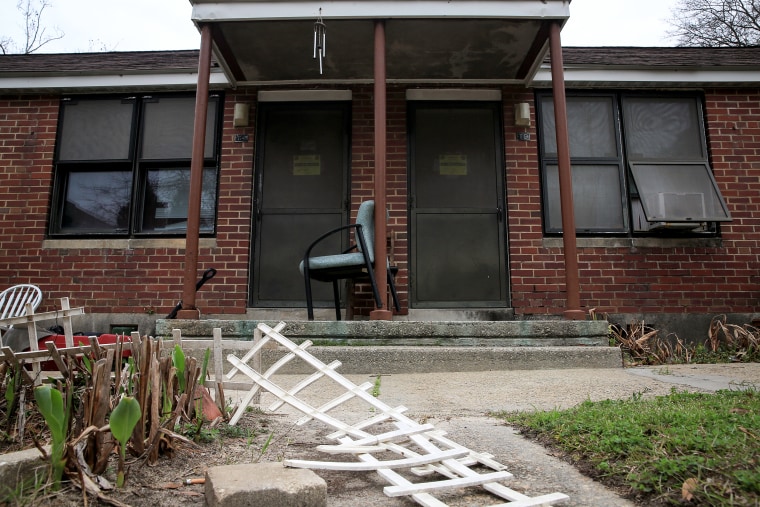The Department of Housing and Urban Development is drafting the first federal rule requiring carbon monoxide detectors in public housing, after an NBC News investigation revealed the lack of protections for millions of low-income residents.
At least 13 people have died from the hazardous gas in federally subsidized housing since 2003, NBC News found.
The new requirement will go through the federal rulemaking process, which means it could be months, at a minimum, before it's implemented.
“A simple, inexpensive, widely available device can be the difference between life and death,” HUD Secretary Ben Carson said in a statement Thursday, announcing the agency’s plans to move forward with the new requirement in both publicly and privately owned HUD housing.
“Given the unevenness of state and local law, we intend to make certain that CO detectors are required in all our housing programs, just as we require smoke detectors, no matter where our HUD-assisted families live,” Carson added.
About half of the states require carbon monoxide detectors in some housing, but those rules don’t always apply to older rental properties, and the regulations are sporadically enforced.
HUD does not require carbon monoxide detectors in public housing, despite the deaths and federal recommendations for all households with fuel-fired appliances or attached garages to install the devices. The new rule would apply to federally subsidized public housing that meets those guidelines.
HUD said that it would use the formal rulemaking process to require the carbon monoxide detectors. That means the agency must release the proposed rule for public comment and respond to the input before it can take effect — the process typically takes months, sometimes years.
In the meantime, HUD is encouraging landlords of federally subsidized housing “to make certain they have working CO detectors in all their housing units/buildings” in states where the devices are required. HUD also “strongly encourage[s]” landlords to install detectors to protect residents in places where the detectors are not required by state or local law, the agency said in a notice released Thursday.
“Because it is impossible to see, taste or smell the toxic fumes, CO can kill you before you are aware it is in your home,” HUD said in the notice. Because of this, the memo continued, “a device — a CO detector — is necessary to determine the presence of high and dangerous concentrations of CO in a residence.”
Housing advocates said they welcome HUD’s latest move, but they urged both the Trump administration and Congress to take further action to protect vulnerable families — and ensure that landlords could afford to do so.
Emily Benfer, a visiting associate clinical professor of law at Columbia University, called HUD’s announcement “an important step in the right direction,” but she worried that the new rule would take too long to implement. She urged the agency to take immediate action.
“HUD could protect tenants now by issuing an interim or direct rule that immediately requires carbon monoxide detectors in federally assisted housing,” Benfer, a public health expert, said. “In a matter of life and death, HUD has good cause to require immediate compliance and notification to tenants of carbon monoxide threats, neither of which are required by this guidance.”
HUD said that it was not within the agency’s authority to impose this requirement immediately, according to spokesman Brian Sullivan.
Industry groups also praised HUD's move but raised concerns that cash-strapped public housing authorities might struggle to install the detectors without additional funding.
“In order to ensure the quick installation of detectors, HUD and Congress must also understand that some agencies that run public housing may need access to additional resources now,” said Sylvia Gimenez, a spokesperson for the National Association of Housing and Redevelopment Officials, a trade group for housing officials.
Sen. Tim Scott, R-S.C., said that he pressed Carson repeatedly to take action on the issue and require detectors. “The senator had a call with Carson directly, as well as sending letters and our staffs meeting multiple times,” Sean Smith, a spokesperson for Scott, said. In January, two residents died of carbon monoxide poisoning in a Columbia, South Carolina, public housing complex that had no detectors.
Last month, members of both the House and Senate introduced bills that would require carbon monoxide detectors in all public housing, including $10 million in funding to help cover the cost of purchasing the devices.
“HUD’s decision underscores the importance of passing the Safe Housing for Families Act which would provide funding and make detectors in public housing required by law across the United States," Rep. Jesus "Chuy" Garcia, D-Ill., who co-sponsored the House bill, said in a statement.
“I look forward to reviewing the rules HUD will issue and will continue to work to ensure that those living in public housing, often communities of color, the elderly and the economically disadvantaged are protected from carbon monoxide poisoning,” Garcia added.
Sullivan, the HUD spokesman, said that existing agency funds from the community development block grant program, public housing capital funds and grants from HUD's Healthy Homes program are "possible sources of federal assistance" for purchasing and installing carbon monoxide detectors.
Each year, at least 430 people die from accidental carbon monoxide poisoning and about 50,000 go to the emergency room, according to the Centers for Disease Control and Prevention. In its guidance, HUD noted that death rates from carbon monoxide are highest for black people and the elderly, both of whom make up a disproportionate number of public housing residents.
Appearing before the House at a recent budget hearing, Carson promised to work with members of Congress “to put some real teeth into legislation” to protect public housing residents from carbon monoxide hazards.



